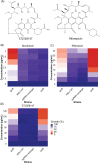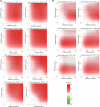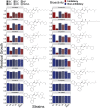A machine learning model trained on a high-throughput antibacterial screen increases the hit rate of drug discovery
- PMID: 36228001
- PMCID: PMC9624395
- DOI: 10.1371/journal.pcbi.1010613
A machine learning model trained on a high-throughput antibacterial screen increases the hit rate of drug discovery
Abstract
Screening for novel antibacterial compounds in small molecule libraries has a low success rate. We applied machine learning (ML)-based virtual screening for antibacterial activity and evaluated its predictive power by experimental validation. We first binarized 29,537 compounds according to their growth inhibitory activity (hit rate 0.87%) against the antibiotic-resistant bacterium Burkholderia cenocepacia and described their molecular features with a directed-message passing neural network (D-MPNN). Then, we used the data to train an ML model that achieved a receiver operating characteristic (ROC) score of 0.823 on the test set. Finally, we predicted antibacterial activity in virtual libraries corresponding to 1,614 compounds from the Food and Drug Administration (FDA)-approved list and 224,205 natural products. Hit rates of 26% and 12%, respectively, were obtained when we tested the top-ranked predicted compounds for growth inhibitory activity against B. cenocepacia, which represents at least a 14-fold increase from the previous hit rate. In addition, more than 51% of the predicted antibacterial natural compounds inhibited ESKAPE pathogens showing that predictions expand beyond the organism-specific dataset to a broad range of bacteria. Overall, the developed ML approach can be used for compound prioritization before screening, increasing the typical hit rate of drug discovery.
Conflict of interest statement
The authors have declared that no competing interests exist.
Figures






Similar articles
-
A Deep Learning Approach to Antibiotic Discovery.Cell. 2020 Feb 20;180(4):688-702.e13. doi: 10.1016/j.cell.2020.01.021. Cell. 2020. PMID: 32084340 Free PMC article.
-
QSAR classification model for antibacterial compounds and its use in virtual screening.J Chem Inf Model. 2012 Oct 22;52(10):2559-69. doi: 10.1021/ci300336v. Epub 2012 Oct 8. J Chem Inf Model. 2012. PMID: 23013546
-
A Pipeline for Screening Small Molecules with Growth Inhibitory Activity against Burkholderia cenocepacia.PLoS One. 2015 Jun 8;10(6):e0128587. doi: 10.1371/journal.pone.0128587. eCollection 2015. PLoS One. 2015. PMID: 26053039 Free PMC article.
-
Emerging structure-based computational methods to screen the exploding accessible chemical space.Curr Opin Struct Biol. 2024 Jun;86:102812. doi: 10.1016/j.sbi.2024.102812. Epub 2024 Apr 10. Curr Opin Struct Biol. 2024. PMID: 38603987 Review.
-
Natural Products as a Source for Novel Antibiotics.Trends Pharmacol Sci. 2016 Aug;37(8):689-701. doi: 10.1016/j.tips.2016.05.001. Epub 2016 Jun 4. Trends Pharmacol Sci. 2016. PMID: 27267698 Review.
Cited by
-
Pre-trained molecular representations enable antimicrobial discovery.Nat Commun. 2025 Apr 10;16(1):3420. doi: 10.1038/s41467-025-58804-4. Nat Commun. 2025. PMID: 40210659 Free PMC article.
-
Machine learning and cheminformatics-based Identification of lichen-derived compounds targeting mutant PBP4R200L in Staphylococcus aureus.Mol Divers. 2025 Aug;29(4):3345-3370. doi: 10.1007/s11030-025-11125-6. Epub 2025 Feb 15. Mol Divers. 2025. PMID: 39954181
-
Synthetic Biology of Natural Products Engineering: Recent Advances Across the Discover-Design-Build-Test-Learn Cycle.ACS Synth Biol. 2024 Sep 20;13(9):2684-2692. doi: 10.1021/acssynbio.4c00391. Epub 2024 Aug 20. ACS Synth Biol. 2024. PMID: 39163395 Free PMC article. Review.
-
Mitigating Molecular Aggregation in Drug Discovery With Predictive Insights From Explainable AI.Angew Chem Int Ed Engl. 2025 Jul;64(29):e202503259. doi: 10.1002/anie.202503259. Epub 2025 Jun 1. Angew Chem Int Ed Engl. 2025. PMID: 40384591 Free PMC article.
-
Innovative perspectives on the discovery of small molecule antibiotics.NPJ Antimicrob Resist. 2025 Mar 13;3(1):19. doi: 10.1038/s44259-025-00089-0. NPJ Antimicrob Resist. 2025. PMID: 40082593 Free PMC article. Review.
References
-
- CDC. Antibiotic Resistance Threats in the United States. Atlanta, GA: U.S. Department of Health and Human Services, CDC; 2019.
Publication types
MeSH terms
Substances
Grants and funding
LinkOut - more resources
Full Text Sources
Molecular Biology Databases

